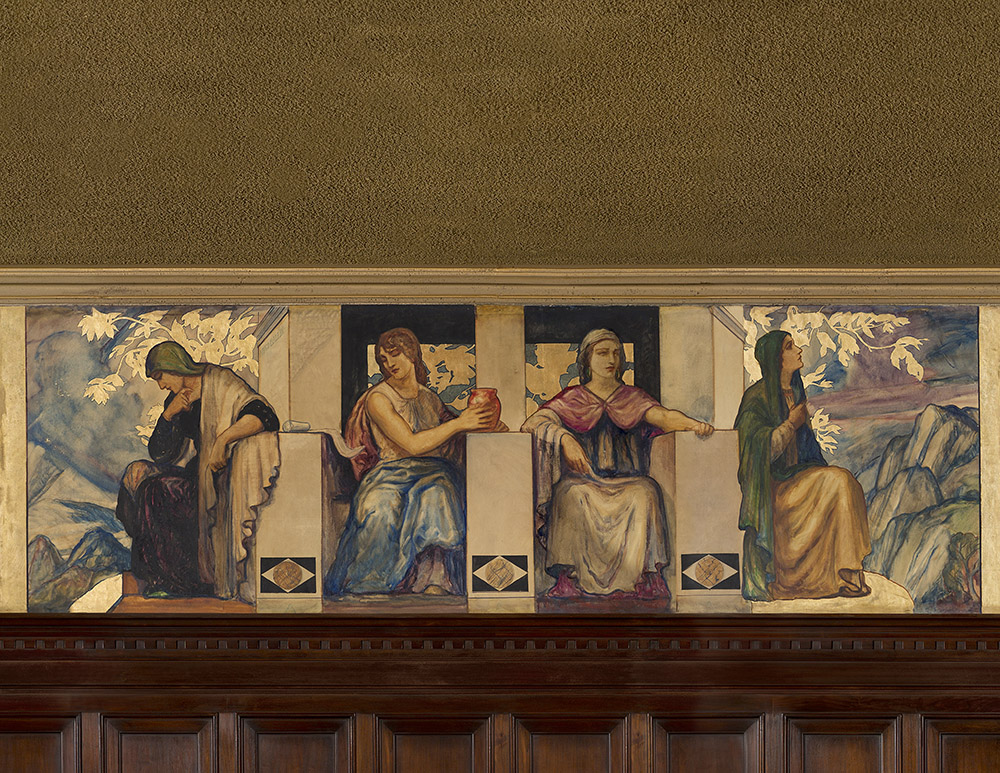Wilshire Boulevard Temple - The Matriarchs

- In Magnin's Words
- Allegory and History
- Source/Citations
Rabbi Edgar F. Magnin described Ballin's murals in a book published in 1974:
"Sarah, Rebeccah [sic], Rachel, and Leah, known in Jewish literature as the Four Mothers of Israel."
"Sarah, Rebeccah [sic], Rachel, and Leah, known in Jewish literature as the Four Mothers of Israel."
Ballin made his name as an artist by painting beautiful women, as both allegorical representations of myths and as embodiments of values and ideals, and may simply have included these "Mothers" to showcase his artistic strengths. However, that Ballin included these female characters, "the Four Mothers of Israel," alongside other portions almost entirely dominated by men implies that he believed these women were just as important to Jewish tradition as Moses, Abraham, Joshua, and other, more well-known Biblical characters. Ballin placed them on the South Wall of the Temple behind the seats, where they face the Altar and preside over the services, echoing the role of women in Jewish households throughout history. Magnin did not include an illustration or elaboration of this portion of the mural in his pamphlet about them, likely reflecting the dearth of writings about the Matriarchs compared to the wealth of materials about the Patriarchs (Abraham, Isaac, and Jacob). Further, men of Magnin's era would have viewed the women as less significant to the history of the Jewish people. Contemporary Jewish feminists, women rabbis, and Biblical scholars have begun to diminish that attitude.
Like the female figures in his early paintings, Ballin placed the Matriarchs in a pastoral setting, removed from the realities of everyday life. Nevertheless, their positions and poses suggest aspects of their characters and experiences as "Mothers" of the nation Israel. On the left, Sarah, the wife of Abraham, looks down, perhaps disconsolate over her long period of childlessness or over the near loss of her only child, Isaac, at the hand of his father. Rebecca, wife of Isaac and mother of Jacob and Esau, holds a pitcher representing her hospitality at the well. Rachel, beloved wife of Jacob, opens her arms in an embracing manner. On the right, Leah appears disconsolate as well, perhaps because she is the unloved wife of Jacob.
Confounding any interpretation of symbolism of the women is the fact that each of the women also resembles Ballin's wife, Mabel, suggesting that this portion of the mural is in some ways an expression of his love and admiration for his wife. Indeed, soon after his marriage, some observers noted that “traces of certain singularly attractive feminine features [were] asserting themselves more and more in his canvasses,” guessing that it might be because he, “unconsciously reproduces her [Mabel's] features in his work."1 Ballin likely felt that Mabel embodied the qualities of each of these mothers and may have aimed to honor her contributions to his household by including the "Four Mothers" in his mural.
Caption from Rabbi Edgar F. Magnin's book, The Warner Murals in the Wilshire Boulevard Temple, Los Angeles, California, published by the Wilshire Boulevard Temple, 1974.
1. Unknown author, "Wife’s Beauty Adds Charm to Artist’s Pictures” New York Herald c. 1910, clipping appears in a scrapbook housed in the Hugo Ballin Papers, Charles Young Library, Dept. of Special Collections, UCLA, Box 29, Folder 2.
| Previous page on path | Wilshire Boulevard Temple - Gallery, page 7 of 12 | Next page on path |

Discussion of "Wilshire Boulevard Temple - The Matriarchs"
Add your voice to this discussion.
Checking your signed in status ...